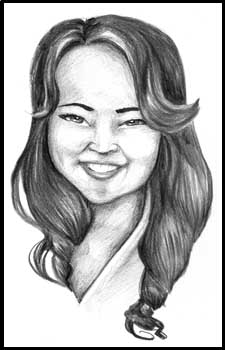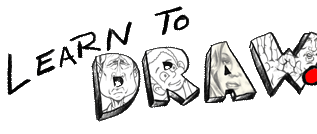 |
People seem to get really scared when they're
asked to draw a human face. This is probably because
they're afraid that they won't be able to make the
drawing look like anybody. Sometimes, even if the person
feels that they can draw, they still don't think they
can draw people. It's not the person that's hard to
draw, it's the likeness that's hard to get. "Likeness"
is the quality of the drawing to "look like" the person
being drawn. Drawing a "generic" person who doesn't look
like anybody that is known is probably a piece of cake
for many people, but when they are asked to draw a
specific person, that's when they freeze up. Why are
likenesses so hard to achieve? I think it goes back to
the "logical" mind and its tendency to create "symbols".
The picture or "symbol" you have in your head of a human
nose doesn't look like the nose that you see on the face
of the person you need to draw. The eyes that you have
pictured in your head - the same eyes you draw when you
just "draw for fun" - don't look like the eyes of the
person you need to draw. So what you need to do when
drawing portraits, is the same thing you need to do when
drawing anything else: You need to lay your "symbols"
aside and draw what you REALLY see. I think there are
three ideas that need to be understood in order to make
a decent portrait: Proportion and perspective, drawing
accurate contours, and creating accurate shading. We'll
look all three of these ideas in this drawing people
section. A major consideration that comes into play in
drawing portraits is proportion and perspective. To
achieve a good likeness proportion is vital. If the
person's eyes are too close together, or if the mouth is
too large, the drawing will not look like the subject.
So to get correct proportions, you're going to have to
use your skill of measuring objects with your pencil.
You have to be really observant in your measurements,
too, because your own mind is going to really be
fighting you and trying to trick you. In portraiture you
really have to draw what you see, and trust the
measurements you take regardless of what your mind tells
you is "correct". These lessons on portraiture are
going to concentrate heavily on proportion and
measurements and less on actual drawing technique, which
is covered in detail in DRAWING BASICS. I'm going to be
giving you some general guidelines on facial proportions
and typical measurements for the human form. All of
these guidelines are for typical or average faces. Since
no one is one hundred percent "average" or "typical",
the measurements you take for your drawings are going to
be slightly different than the ones I give here, but
these ideas will give you general rules about
proportions and measurements. |
